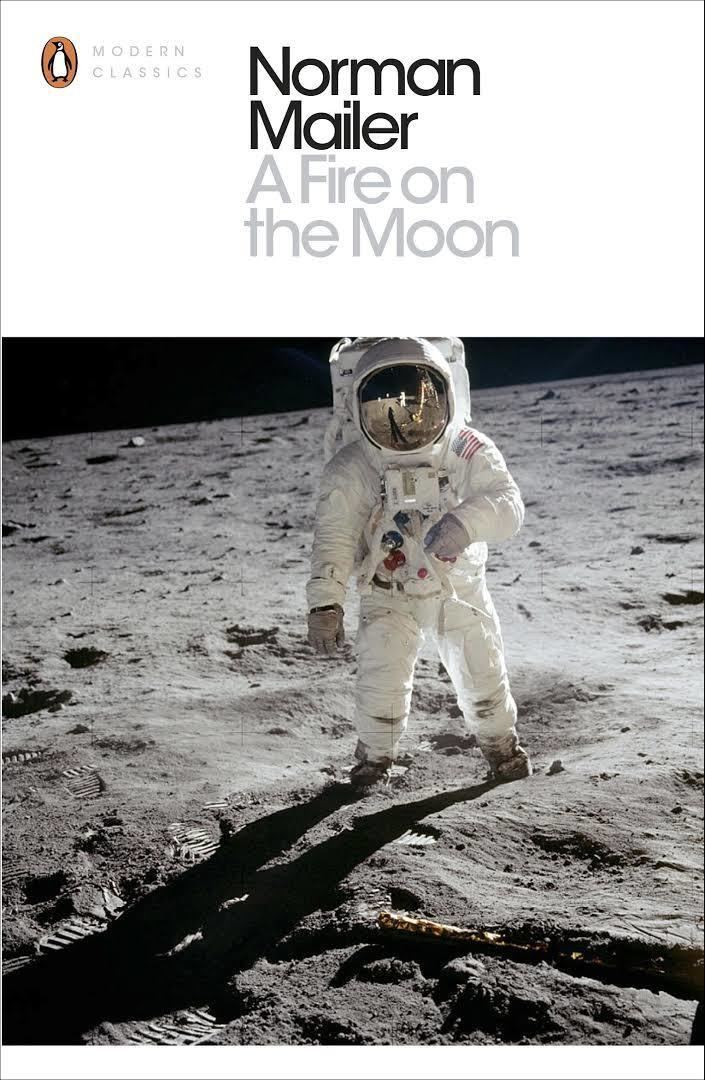7.6 /10 1 Votes7.6
Originally published 1970 | 3.8/5 Goodreads | |||||||||||||||||||||||||||||||||
 | ||||||||||||||||||||||||||||||||||
Similar Works by Norman Mailer, Astronaut books | ||||||||||||||||||||||||||||||||||
Of a Fire on the Moon (ISBN 0-316-54411-6, OCLC 101602) is a work of non-fiction by Norman Mailer which was serialised in Life magazine in 1969 and 1970, and published in 1970 as a book. It is a documentary and reflection on the Apollo 11 moon landing from Mailer's point of view.
Contents
Writing and publication
After spending time at the space center and mission control in Houston, and witnessing the launch of the Saturn V at Cape Kennedy in Florida, Mailer began writing his account of the historic voyage at his home in Provincetown, Massachusetts during marathon writing sessions to meet his deadlines for the magazine. His account, which ran to 115,000 words, was published between August 1969 and January 1970 in three long installments—A Fire on the Moon, The Psychology of Astronauts, and A Dream of the Future's Face.
In a foreword to Mailer's first installment, Life Managing Editor Ralph Graves introduced "some 26,000 words—the longest non-fiction piece Life has ever published in one issue."
On February 26, 1970, after the magazine series had concluded, Mailer wrote to Apollo 11 commander, Neil Armstrong, "I've worked as assiduously as any writer I know to portray the space program in its largest, not its smallest, dimension".
His account was published as a book called Of a Fire on the Moon in 1970. In the UK, it was published with its original article title, A Fire on the Moon.
Various interpretations and meanings
Of a Fire on the Moon, published in three installments by Life magazine, later becoming a full book, chronicles the U.S. moon launch of 1969 through the eyes of Norman Mailer’s third-person view of himself. Through this third-person view, Mailer describes the space launches from his point of view as seasoned reporter who has seen America ‘come of age’ since the end of the Second World War. Additionally, Mailer strings in short "time machines" (as made popular in his literary debut, The Naked and the Dead) which provide insight from fictional American families as they view the news coverage and actual moon launch. By providing the reader with multiple illustrations of the moon launch, the reader is able to see what the monumental moment means to different Americans. For some of the depicted characters, it is as simple as the epitome of American ingenuity and superiority in the context of the Cold War with the Soviet Union. Mailer’s third-person depiction illustrates an amalgamation of emotions that combines the awe of the scientific feat with the fear of the ever-increasing power of the human race. To Mailer, the moon launch is much more than an accomplishment of the United States, nor is it a move to conquer the Space Race with the Soviet Union. He sees it as a triumph for all humankind, a bold statement in the face of the "creator". By landing men on a celestial object such as the moon, humans are seen as rejecting the omniscient power of a higher entity, almost saying, “Look how far we have come.”
Mailer’s generation has experienced the industrial slaughter of humans with the Holocaust, the immediate flattening of modern cities with the atomic bomb, and now the landing of men on the moon, a seemingly impossible task only a few decades prior. Therefore, the reader can understand why Mailer sees the moon launch as a potentially dangerous step for humankind, forcing one to think not solely about America’s role at the turn of the decade, but the future of humankind on Earth. While Of a Fire on the Moon takes time to praise NASA in the aftermath of the successful moon launch, its poignant publication in the months following the launch comes as a sobering blow to the consciousness of Americans who have yet to dissect the moon launch as anything other than a moment of American supremacy.
$112,500 coffee table edition
The 40th anniversary of the first moon landing was marked in 2009 by the release of an abridged, limited edition of the text, re-packaged with images from NASA and Life magazine. This production retitled the work, MoonFire, and was presented in an aluminium box with a lid shaped like the crater-pocked surface of the moon; the object was mounted on four legs resembling lunar module struts. Thus, the coffee table book came inside its own lunar-themed "coffee table", with an uneven surface (see photograph). The package included a numbered print of the famous portrait of Buzz Aldrin standing on the moon, framed in plexiglass and signed by the astronaut himself—and enclosed a lunar meteorite. Only 12 were created and the price was $112,500.
Norman Mailer died two years before the package was launched.
Painting on first edition cover
The painting on the cover of the first edition (Little, Brown & Co, 1970) is Le Monde Invisible, a 1954 oil painting by René Magritte. Mailer describes seeing this painting in Chapter 5 ("A Dream of the Future's Face") of the first part ("Aquarius"). "In the foyer was a painting by Magritte, a startling image of a room with an immense rock situated in the center of the floor." The 1970 dust jacket cites that the painting is part of a private collection.
Editions and title variations
- Life serializations:Part I: "A Fire on the Moon" — Life magazine, 29 August 1969.Part II: "The Psychology of Astronauts" — Life magazine, 14 November 1969.Part III: "A Dream of the Future's Face" — Life magazine, 9 January 1970.
- Of a Fire on the Moon — Little, Brown & Co, Boston, 1970, ISBN 0-316-54411-6.
- A Fire on the Moon — Weidenfeld & Nicolson, London, 1970, ISBN 0-297-17952-7.
- MoonFire: The Epic Journey of Apollo 11 — Taschen GmbH, Köln, 2009, ISBN 3-8365-1179-7, ISBN 3-8365-2077-X.
